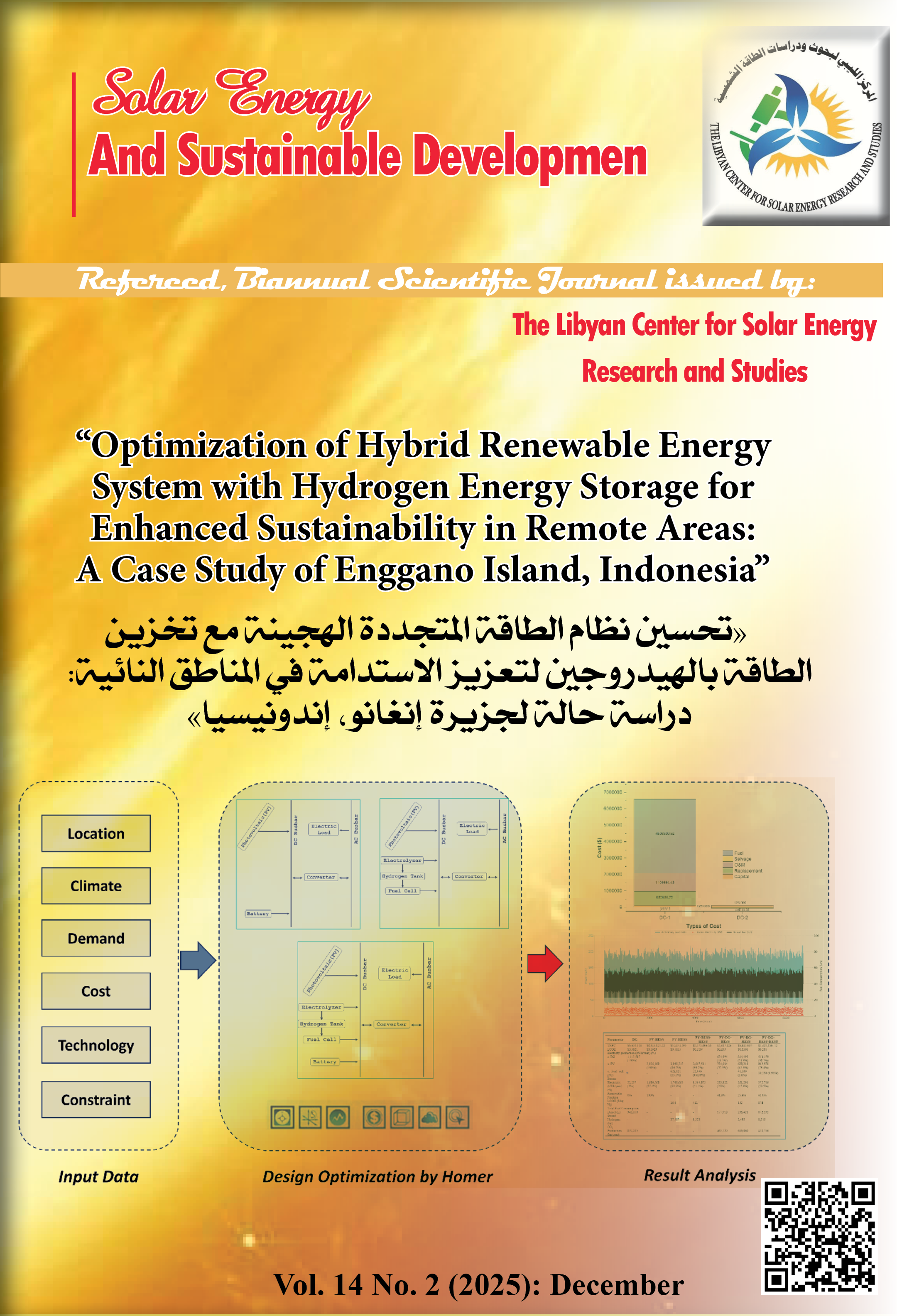Optimization of Hybrid Renewable Energy System with Hydrogen Energy Storage for Enhanced Sustainability in Remote Areas:
A Case Study of Enggano Island, Indonesia
DOI:
https://doi.org/10.51646/jsesd.v14i2.618Keywords:
Hybrid Renewable Energy System, Hydrogen Energy Storage, Remote Areas, photovoltaic fault detection, Net Present Cost.Abstract
The growing global energy demand and the impacts of climate change have accelerated the transition toward renewable energy, particularly in remote regions not connected to national electricity grids. This study investigates the design and optimization of a Hybrid Renewable Energy System (HRES) that integrates photovoltaic (PV) panels, diesel generators (DG), battery energy storage systems (BESS), and hydrogen energy storage systems (HESS) to meet the electricity demand of Enggano Island, Indonesia. The objective is to reduce dependence on fossil fuels, thereby lowering greenhouse gas emissions and improving cost efficiency. Simulations were conducted using HOMER software to determine the optimal system configuration based on economic, technical, and environmental indicators, including Net Present Cost (NPC), Levelized Cost of Energy (LCOE), Renewable Fraction (RF), and CO₂ emissions. The results show that the PV-DG-BESS configuration emerged as the most cost-effective and environmentally sustainable option, achieving an LCOE of $0.293/kWh and reducing annual CO₂ emissions by 48.1% compared to the baseline diesel-only scenario. The Net Present Cost (NPC) for PV-DG-BESS was calculated to be $5,387,226.63. While the PV-DG-BESS configuration is the most practical near-term solution, the integration of HESS demonstrates long-term potential for enhancing system resilience and supporting deeper renewable penetration. Overall, this study contributes to the development of sustainable and efficient renewable energy strategies for remote areas and provides valuable insights for policymakers and energy practitioners in Indonesia and other developing countries facing similar energy challenges.
Downloads
Metrics
References
M. H. Jahangir, F. Javanshir, and A. Kargarzadeh, “Economic analysis and optimal design of hydrogen/diesel backup system to improve energy hubs providing the demands of sport complexes,” Int. J. Hydrogen Energy, vol. 46, no. 27, pp. 14109–14129, 2021, doi: 10.1016/j.ijhydene.2021.01.187. DOI: https://doi.org/10.1016/j.ijhydene.2021.01.187
J. L. Holechek, H. M. E. Geli, M. N. Sawalhah, and R. Valdez, “A Global Assessment: Can Renewable Energy Replace Fossil Fuels by 2050?,” Sustainability, vol. 14, no. 8, p. 4792, Apr. 2022, doi: 10.3390/su14084792. DOI: https://doi.org/10.3390/su14084792
S. Arbye, F. D. Wijaya, and A. Budiman, “Water Electrolysis Technology Selection for Green Hydrogen Production in Coastal Isolated Area,” Eng. J., vol. 28, no. 11, pp. 1–16, Nov. 2024, doi: 10.4186/ej.2024.28.11.1. DOI: https://doi.org/10.4186/ej.2024.28.11.1
T. Khan, M. Waseem, M. Tahir, S. Liu, and M. Yu, “Autonomous hydrogen-based solar-powered energy system for rural electrification in Balochistan, Pakistan: An energy-economic feasibility analysis,” Energy Convers. Manag., vol. 271, no. September, 2022, doi: 10.1016/j.enconman.2022.116284. DOI: https://doi.org/10.1016/j.enconman.2022.116284
W. López-Castrillón, H. H. Sepúlveda, and C. Mattar, “Off-Grid Hybrid Electrical Generation Systems in Remote Communities: Trends and Characteristics in Sustainability Solutions,” Sustainability, vol. 13, no. 11, p. 5856, May 2021, doi: 10.3390/su13115856. DOI: https://doi.org/10.3390/su13115856
A. Saputra, A. Setyawan, Chairiman, A. I. Putri, and L. J. Diguna, “Techno-economic analysis of hybrid PV-Battery-diesel system for isolated Dockyard In West Papua,” E3S Web Conf., vol. 475, p. 03008, Jan. 2024, doi: 10.1051/e3sconf/202447503008. DOI: https://doi.org/10.1051/e3sconf/202447503008
M. Thirunavukkarasu, Y. Sawle, and H. Lala, “A comprehensive review on optimization of hybrid renewable energy systems using various optimization techniques,” Renew. Sustain. Energy Rev., vol. 176, no. February, p. 113192, Apr. 2023, doi: 10.1016/j.rser.2023.113192. DOI: https://doi.org/10.1016/j.rser.2023.113192
P. Choudhary and R. K. Srivastava, “Sustainability perspectives- a review for solar photovoltaic trends and growth opportunities,” J. Clean. Prod., vol. 227, pp. 589–612, Aug. 2019, doi: 10.1016/j.jclepro.2019.04.107. DOI: https://doi.org/10.1016/j.jclepro.2019.04.107
P. Das, B. K. Das, N. N. Mustafi, and M. T. Sakir, “A review on pump‐hydro storage for renewable and hybrid energy systems applications,” Energy Storage, vol. 3, no. 4, pp. 1–24, Aug. 2021, doi: 10.1002/est2.223. DOI: https://doi.org/10.1002/est2.223
P. Pal and V. Mukherjee, “Off-grid solar photovoltaic/hydrogen fuel cell system for renewable energy generation: An investigation based on techno-economic feasibility assessment for the application of end-user load demand in North-East India,” Renew. Sustain. Energy Rev., vol. 149, no. July, p. 111421, Oct. 2021, doi: 10.1016/j.rser.2021.111421. DOI: https://doi.org/10.1016/j.rser.2021.111421
H. Hassani, F. Zaouche, D. Rekioua, S. Belaid, T. Rekioua, and S. Bacha, “Feasibility of a standalone photovoltaic/battery system with hydrogen production,” J. Energy Storage, vol. 31, no. June, p. 101644, 2020, doi: 10.1016/j.est.2020.101644. DOI: https://doi.org/10.1016/j.est.2020.101644
M. H. Hassan, S. Kamel, M. Safaraliev, and S. Kokin, “Improved techno-economic optimization of hybrid solar/wind/fuel cell/diesel systems with hydrogen energy storage,” Int. J. Hydrogen Energy, vol. 68, no. 6, pp. 998–1018, May 2024, doi: 10.1016/j.ijhydene.2024.04.124. DOI: https://doi.org/10.1016/j.ijhydene.2024.04.124
A. Budiman, F. D. Wijaya, I. Technology, U. G. Mada, and U. G. Mada, “Trend of Research on Green Hydrogen Production Based on Scopus Database: A Bibliometric Analysis,” Int. J. Renew. Energy Res., vol. 15, no. vol15i3, 2025, doi: 10.20508/ijrer.v15i3.14905.g9084. DOI: https://doi.org/10.20508/ijrer.v15i3.14905.g9084
S. Arbye, F. Wijaya, and A. Budiman, “An overview of green hydrogen production system through low temperature water electrolysis using solar energy,” Therm. Sci., vol. 28, no. 5 Part A, pp. 3657–3674, 2024, doi: 10.2298/TSCI231120084A. DOI: https://doi.org/10.2298/TSCI231120084A
M. G. Rasul, M. . Hazrat, M. A. Sattar, M. I. Jahirul, and M. J. Shearer, “The future of hydrogen: Challenges on production, storage and applications,” Energy Convers. Manag., vol. 272, no. September, p. 116326, Nov. 2022, doi: 10.1016/j.enconman.2022.116326. DOI: https://doi.org/10.1016/j.enconman.2022.116326
J. de la Cruz-Soto, I. Azkona-Bedia, N. Velazquez-Limon, and T. Romero-Castanon, “A techno-economic study for a hydrogen storage system in a microgrid located in baja California, Mexico. Levelized cost of energy for power to gas to power scenarios,” Int. J. Hydrogen Energy, vol. 47, no. 70, pp. 30050–30061, 2022, doi: 10.1016/j.ijhydene.2022.03.026. DOI: https://doi.org/10.1016/j.ijhydene.2022.03.026
J. C. Alberizzi, J. M. Frigola, M. Rossi, and M. Renzi, “Optimal sizing of a Hybrid Renewable Energy System: Importance of data selection with highly variable renewable energy sources,” Energy Convers. Manag., vol. 223, no. March, p. 113303, Nov. 2020, doi: 10.1016/j.enconman.2020.113303. DOI: https://doi.org/10.1016/j.enconman.2020.113303
A. A. Khan and A. F. Minai, “A strategic review: the role of commercially available tools for planning, modelling, optimization, and performance measurement of photovoltaic systems,” Energy Harvest. Syst., vol. 11, no. 1, pp. 1–23, Jan. 2024, doi: 10.1515/ehs-2022-0157. DOI: https://doi.org/10.1515/ehs-2022-0157
K. A. Kavadias and P. Triantafyllou, “Hybrid Renewable Energy Systems’ Optimisation. A Review and Extended Comparison of the Most-Used Software Tools,” Energies, vol. 14, no. 24, p. 8268, Dec. 2021, doi: 10.3390/en14248268. DOI: https://doi.org/10.3390/en14248268
C. Laghlimi, A. Moutcine, Y. Ziat, H. Belkhanchi, A. Koufi, and S. Bouyassan, “Hydrogen, Chronology and Electrochemical Production,” Sol. Energy Sustain. Dev. J., vol. 12, no. 2, pp. 22–37, Dec. 2024, doi: 10.51646/jsesd.v14iSI_MSMS2E.405. DOI: https://doi.org/10.51646/jsesd.v14iSI_MSMS2E.405
L. Rtemi, W. El-Osta, and A. Attaiep, “Hybrid System Modeling for Renewable Energy Sources,” Sol. Energy Sustain. Dev. J., vol. 12, no. 1, pp. 13–28, Jul. 2023, doi: 10.51646/jsesd.v12i1.146. DOI: https://doi.org/10.51646/jsesd.v12i1.146
B. A. Medjo Nouadje, P. Tiam Kapen, V. Chegnimonhan, and R. Tchinda, “Techno-economic analysis of a grid/fuel cell/PV/electrolyzer system for hydrogen and electricity production in the countries of African and Malagasy council for higher education (CAMES),” Energy Strateg. Rev., vol. 53, no. December 2023, p. 101392, May 2024, doi: 10.1016/j.esr.2024.101392. DOI: https://doi.org/10.1016/j.esr.2024.101392
S. S. Mohammad and S. J. Iqbal, “Hydrogen technology supported solar photovoltaic-based microgrid for urban apartment buildings: Techno-economic analysis and optimal design,” Energy Convers. Manag., vol. 302, no. January, 2024, doi: 10.1016/j.enconman.2024.118146. DOI: https://doi.org/10.1016/j.enconman.2024.118146
S. M. Seyed Alavi, A. Maleki, A. Noroozian, and A. Khaleghi, “Simultaneous optimal site selection and sizing of a grid-independent hybrid wind/hydrogen system using a hybrid optimization method based on ELECTRE: A case study in Iran,” Int. J. Hydrogen Energy, vol. 55, no. July 2023, pp. 970–983, 2024, doi: 10.1016/j.ijhydene.2023.11.110. DOI: https://doi.org/10.1016/j.ijhydene.2023.11.110
M. Wong et al., “Design and Techno-Economic Analysis of a Hydrogen-Based Micro Hydro-Solar Hybrid Energy System for Sustainable Energy Access: A Case Study in Sri Aman, Sarawak,” Int. J. Electr. Electron. Eng. Telecommun., vol. 13, no. 1, pp. 33–44, 2024, doi: 10.18178/ijeetc.13.1.33-44. DOI: https://doi.org/10.18178/ijeetc.13.1.33-44
M. Urf Manoo, F. Shaikh, L. Kumar, and M. Arıcı, “Comparative techno-economic analysis of various stand-alone and grid connected (solar/wind/fuel cell) renewable energy systems,” Int. J. Hydrogen Energy, vol. 52, pp. 397–414, 2024, doi: 10.1016/j.ijhydene.2023.05.258. DOI: https://doi.org/10.1016/j.ijhydene.2023.05.258
A. S. Menesy et al., “Techno-economic optimization framework of renewable hybrid photovoltaic/wind turbine/fuel cell energy system using artificial rabbits algorithm,” IET Renew. Power Gener., no. January, pp. 1–18, 2024, doi: 10.1049/rpg2.12938. DOI: https://doi.org/10.1049/rpg2.12938
A. Q. Al-Shetwi, I. E. Atawi, A. Abuelrub, and M. A. Hannan, “Techno-economic assessment and optimal design of hybrid power generation-based renewable energy systems,” Technol. Soc., vol. 75, no. September, p. 102352, Nov. 2023, doi: 10.1016/j.techsoc.2023.102352. DOI: https://doi.org/10.1016/j.techsoc.2023.102352
L. El boujdaini, F. Jurado, A. Mezrhab, M. A. Moussaoui, and D. Vera, “Cost and size optimization of hybrid solar and hydrogen subsystem using HomerPro software,” Int. J. Hydrogen Energy, vol. 48, no. 62, pp. 24018–24036, 2023, doi: 10.1016/j.ijhydene.2023.03.199. DOI: https://doi.org/10.1016/j.ijhydene.2023.03.199
P. M. Thampi, “Feasibility analysis of a PV-H2-Battery system for a data center in Luleå,” KTH, School of Industrial Engineering and Management (ITM)., 2023.
J. Yang, Y.-L. Chen, P. L. Yee, C. S. Ku, and M. Babanezhad, “An Improved Artificial Ecosystem-Based Optimization Algorithm for Optimal Design of a Hybrid Photovoltaic/Fuel Cell Energy System to Supply A Residential Complex Demand: A Case Study for Kuala Lumpur,” Energies, vol. 16, no. 6, p. 2867, Mar. 2023, doi: 10.3390/en16062867. DOI: https://doi.org/10.3390/en16062867
W. Chaichan, J. Waewsak, R. Nikhom, C. Kongruang, S. Chiwamongkhonkarn, and Y. Gagnon, “Optimization of stand-alone and grid-connected hybrid solar/wind/fuel cell power generation for green islands: Application to Koh Samui, southern Thailand,” Energy Reports, vol. 8, no. May, pp. 480–493, 2022, doi: 10.1016/j.egyr.2022.07.024. DOI: https://doi.org/10.1016/j.egyr.2022.07.024
V. M. Phap et al., “Feasibility analysis of hydrogen production potential from rooftop solar power plant for industrial zones in Vietnam,” Energy Reports, vol. 8, pp. 14089–14101, 2022, doi: 10.1016/j.egyr.2022.10.337. DOI: https://doi.org/10.1016/j.egyr.2022.10.337
M. D. Wilopo, Y. P. Sari, M. A. F. Utami, E. Vandana, and E. E. Permanda, “The diversity of coral reefs in Kaana Waters Enggano Island, Bengkulu,” E3S Web Conf., vol. 373, p. 02002, Mar. 2023, doi: 10.1051/e3sconf/202337302002. DOI: https://doi.org/10.1051/e3sconf/202337302002
Dyah Ayu Kartika Sari, Fransisco Danang Wijaya, and Husni Rois Ali, “Optimasi Sistem Pembangkit Listrik Tenaga Hybrid di Pulau Enggano,” J. Nas. Tek. Elektro dan Teknol. Inf., vol. 11, no. 2, pp. 154–160, May 2022, doi: 10.22146/jnteti.v11i2.3849. DOI: https://doi.org/10.22146/jnteti.v11i2.3849
N. Daratha, I. Agustian, D. Suryadi, A. Suandi, and N. Gupta, “Development of Low-Cost Wind Power Estimation System in Enggano Island Indonesia,” in Lecture Notes in Mechanical Engineering, 2019, pp. 173–181. DOI: https://doi.org/10.1007/978-981-13-6577-5_18
T. M. I. Riayatsyah, T. A. Geumpana, I. M. R. Fattah, and T. M. I. Mahlia, “Techno-Economic Analysis of Hybrid Diesel Generators and Renewable Energy for a Remote Island in the Indian Ocean Using HOMER Pro,” Sustainability, vol. 14, no. 16, p. 9846, Aug. 2022, doi: 10.3390/su14169846. DOI: https://doi.org/10.3390/su14169846
A. Xu, L. J. Awalin, A. Al-Khaykan, H. F. Fard, I. Alhamrouni, and M. Salem, “Techno-Economic and Environmental Study of Optimum Hybrid Renewable Systems, including PV/Wind/Gen/Battery, with Various Components to Find the Best Renewable Combination for Ponorogo Regency, East Java, Indonesia,” Sustainability, vol. 15, no. 3, p. 1802, Jan. 2023, doi: 10.3390/su15031802. DOI: https://doi.org/10.3390/su15031802
M. Rezaei, U. Dampage, B. K. Das, O. Nasif, P. F. Borowski, and M. A. Mohamed, “Investigating the Impact of Economic Uncertainty on Optimal Sizing of Grid-Independent Hybrid Renewable Energy Systems,” Processes, vol. 9, no. 8, p. 1468, Aug. 2021, doi: 10.3390/pr9081468. DOI: https://doi.org/10.3390/pr9081468
P. Tiam Kapen, B. A. Medjo Nouadje, V. Chegnimonhan, G. Tchuen, and R. Tchinda, “Techno-economic feasibility of a PV/battery/fuel cell/electrolyzer/biogas hybrid system for energy and hydrogen production in the far north region of cameroon by using HOMER pro,” Energy Strateg. Rev., vol. 44, no. July, 2022, doi: 10.1016/j.esr.2022.100988. DOI: https://doi.org/10.1016/j.esr.2022.100988
T. M. I. Riayatsyah, T. A. Geumpana, I. M. R. Fattah, S. Rizal, and T. M. I. Mahlia, “Techno-Economic Analysis and Optimisation of Campus Grid-Connected Hybrid Renewable Energy System Using HOMER Grid,” Sustainability, vol. 14, no. 13, p. 7735, Jun. 2022, doi: 10.3390/su14137735. DOI: https://doi.org/10.3390/su14137735
A. N. Shafira, S. Petrana, R. Muthia, and W. W. Purwanto, “Techno-economic analysis of a hybrid renewable energy system integrated with productive activities in an underdeveloped rural region of eastern Indonesia,” Clean Energy, vol. 7, no. 6, pp. 1247–1267, Dec. 2023, doi: 10.1093/ce/zkad068. DOI: https://doi.org/10.1093/ce/zkad068
S. Yadav, P. Kumar, and A. Kumar, “Techno-economic assessment of hybrid renewable energy system with multi energy storage system using HOMER,” Energy, vol. 297, no. September 2023, p. 131231, Jun. 2024, doi: 10.1016/j.energy.2024.131231. DOI: https://doi.org/10.1016/j.energy.2024.131231
P. P Kumar and R. P. Saini, “Optimization of an off-grid integrated hybrid renewable energy system with various energy storage technologies using different dispatch strategies,” Energy Sources, Part A Recover. Util. Environ. Eff., vol. 00, no. 00, pp. 1–30, Oct. 2020, doi: 10.1080/15567036.2020.1824035. DOI: https://doi.org/10.1080/15567036.2020.1824035
H. A. Khamis, E. Mashhour, M. Joorabian, S. G. Seifossadat, and S. H. Hammadi, “Operation Strategy for a Stand-Alone Hybrid Energy System Supplying a Remote Residential Home for Minimizing Total Cost and Carbon Emission Equipped With Geothermal System,” IEEE Access, vol. 12, no. August, pp. 120687–120710, 2024, doi: 10.1109/ACCESS.2024.3451535. DOI: https://doi.org/10.1109/ACCESS.2024.3451535
P. C. Okonkwo et al., “A techno-economic analysis of renewable hybrid energy systems for hydrogen production at refueling stations,” Int. J. Hydrogen Energy, vol. 78, no. February, pp. 68–82, Aug. 2024, doi: 10.1016/j.ijhydene.2024.06.294. DOI: https://doi.org/10.1016/j.ijhydene.2024.06.294
T. Xia et al., “Techno-Economic Assessment of a Grid-Independent Hybrid Power Plant for Co-Supplying a Remote Micro-Community with Electricity and Hydrogen,” Processes, vol. 9, no. 8, p. 1375, Aug. 2021, doi: 10.3390/pr9081375. DOI: https://doi.org/10.3390/pr9081375
F. Odoi-Yorke and A. Woenagnon, “Techno-economic assessment of solar PV/fuel cell hybrid power system for telecom base stations in Ghana,” Cogent Eng., vol. 8, no. 1, Jan. 2021, doi: 10.1080/23311916.2021.1911285. DOI: https://doi.org/10.1080/23311916.2021.1911285
C. Li, “Technical and economic potential evaluation of an off-grid hybrid wind-fuel cell-battery energy system in Xining, China,” Int. J. Green Energy, vol. 18, no. 3, pp. 258–270, Feb. 2021, doi: 10.1080/15435075.2020.1854267. DOI: https://doi.org/10.1080/15435075.2020.1854267
F. Oueslati and N. Toumi, “Technical feasibility and financial assessment of autonomous hydrogen refuelling stations fully supplied by mixed renewable energy systems for twenty selected sites located in France,” Environ. Dev. Sustain., no. 0123456789, Apr. 2024, doi: 10.1007/s10668-024-04872-3. DOI: https://doi.org/10.1007/s10668-024-04872-3
S. R. Shakya et al., “Estimation of air pollutant emissions from captive diesel generators and its mitigation potential through microgrid and solar energy,” Energy Reports, vol. 8, pp. 3251–3262, Nov. 2022, doi: 10.1016/j.egyr.2022.02.084. DOI: https://doi.org/10.1016/j.egyr.2022.02.084
M. M. A. Seedahmed, M. A. M. Ramli, H. R. E. H. Bouchekara, M. S. Shahriar, A. H. Milyani, and M. Rawa, “A techno-economic analysis of a hybrid energy system for the electrification of a remote cluster in western Saudi Arabia,” Alexandria Eng. J., vol. 61, no. 7, pp. 5183–5202, 2022, doi: 10.1016/j.aej.2021.10.041. DOI: https://doi.org/10.1016/j.aej.2021.10.041

Downloads
Published
How to Cite
Issue
Section
License
Copyright (c) 2025 Solar Energy and Sustainable Development Journal

This work is licensed under a Creative Commons Attribution-NonCommercial 4.0 International License.













